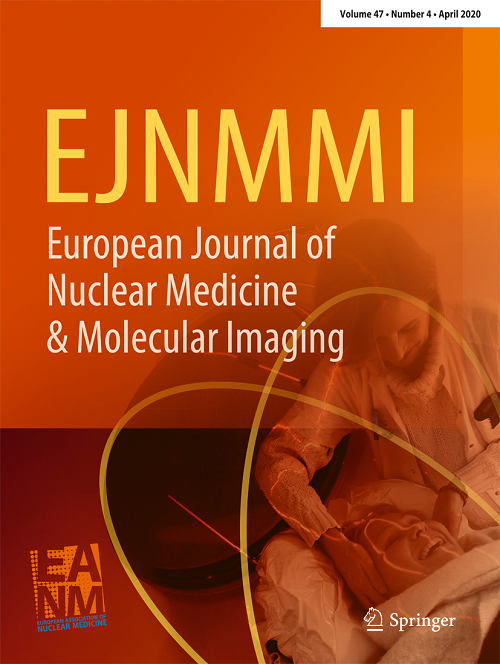Revealing the hidden: A systematic review and meta-analysis of FAPI-based tracers imaging for brain metastatic lesions.
IF 7.6
1区 医学
Q1 RADIOLOGY, NUCLEAR MEDICINE & MEDICAL IMAGING
European Journal of Nuclear Medicine and Molecular Imaging
Pub Date : 2025-10-07
DOI:10.1007/s00259-025-07576-6
引用次数: 0
Abstract
BACKGROUND Regarding the assessment of brain metastatic lesions, [18F]FDG PET/CT encounters challenges due to heightened physiological uptake in normal brain tissue, resulting in poor tumor-to-background ratios (TBR). Detecting brain metastases accurately has long been a challenge with standard imaging methods. The elevated physiological uptake of [18F]FDG in normal brain parenchyma limits its ability to distinguish metastatic lesions owing to poor tumor-to-background contrast. On the other hand, radiolabeled fibroblast activation protein inhibitors (FAPI) have emerged as a newer imaging tracer, showing promise. This study aimed to collect available literature to assess FAPI's ability to detect brain metastases across various cancer types. METHODS We reviewed studies published up to April 2025, utilizing different databases, including Google Scholar, PubMed, and Scopus, primarily examining the performance of FAPI based on standardized uptake values (SUVs) and TBRs. Studies focusing on the diagnostic performance of FAPI-based PET for brain metastasis were included. The primary endpoint was the detection rate of FAPI-based tracers. RESULTS In 24 studies involving over 115 patients and more than 291 lesions, FAPI-based imaging detected of 87.9% lesions (95% CI: 76.1-94.3%, p < 0.001) compared to [18F]FDG by the detection rate of 46.3% (95% CI: 30.6-62.8%, p = 0.667). The comparison of detection rates of these modalities showed an OR of 10.78 (95% CI: 5.15-22.55, p < 0.001). FAPI radiotracers exhibited higher TBR compared to [18F]FDG PET/CT (SMD: 1.51, 95% CI: 0.86-2.16, p < 0.001). CONCLUSION In conclusion, FAPI-based tracers seem to surpass [18F]FDG PET in identifying brain metastases. FAPI imaging can potentially serve as a diagnostic tool that offers benefits over traditional methods. Further research is needed to verify its clinical effectiveness.揭示隐藏:基于fapi的脑转移病灶示踪成像的系统回顾和荟萃分析。
关于脑转移病变的评估,[18F]由于FDG PET/CT在正常脑组织中的生理摄取增加,导致肿瘤与背景比(TBR)较差,因此面临挑战。长期以来,准确检测脑转移一直是标准成像方法的挑战。正常脑实质中[18F]FDG的生理摄取升高,由于肿瘤-背景对比差,限制了其区分转移性病变的能力。另一方面,放射性标记成纤维细胞活化蛋白抑制剂(FAPI)作为一种较新的成像示踪剂出现,显示出前景。本研究旨在收集现有文献,以评估FAPI检测各种癌症类型脑转移的能力。方法我们回顾了截至2025年4月发表的研究,利用不同的数据库,包括谷歌Scholar、PubMed和Scopus,主要基于标准化摄取值(suv)和tbr来检查FAPI的性能。研究集中在fapi为基础的PET对脑转移的诊断性能。主要终点是基于fapi的示踪剂的检出率。结果在24项研究中,115例以上患者、291个病变中,fapi影像学检出率为87.9% (95% CI: 76.1 ~ 94.3%, p < 0.001), FDG影像学检出率为46.3% (95% CI: 30.6 ~ 62.8%, p = 0.667)。这些模式的检出率比较显示OR为10.78 (95% CI: 5.15 ~ 22.55, p < 0.001)。FAPI示踪剂的TBR高于FDG PET/CT [18F] (SMD: 1.51, 95% CI: 0.86-2.16, p < 0.001)。结论基于fapi的示踪剂在鉴别脑转移瘤方面似乎优于[18F]FDG PET。FAPI成像可以作为潜在的诊断工具,提供优于传统方法的优点。临床有效性有待进一步研究验证。
本文章由计算机程序翻译,如有差异,请以英文原文为准。
求助全文
约1分钟内获得全文
求助全文
来源期刊
CiteScore
15.60
自引率
9.90%
发文量
392
审稿时长
3 months
期刊介绍:
The European Journal of Nuclear Medicine and Molecular Imaging serves as a platform for the exchange of clinical and scientific information within nuclear medicine and related professions. It welcomes international submissions from professionals involved in the functional, metabolic, and molecular investigation of diseases. The journal's coverage spans physics, dosimetry, radiation biology, radiochemistry, and pharmacy, providing high-quality peer review by experts in the field. Known for highly cited and downloaded articles, it ensures global visibility for research work and is part of the EJNMMI journal family.

 求助内容:
求助内容: 应助结果提醒方式:
应助结果提醒方式:


